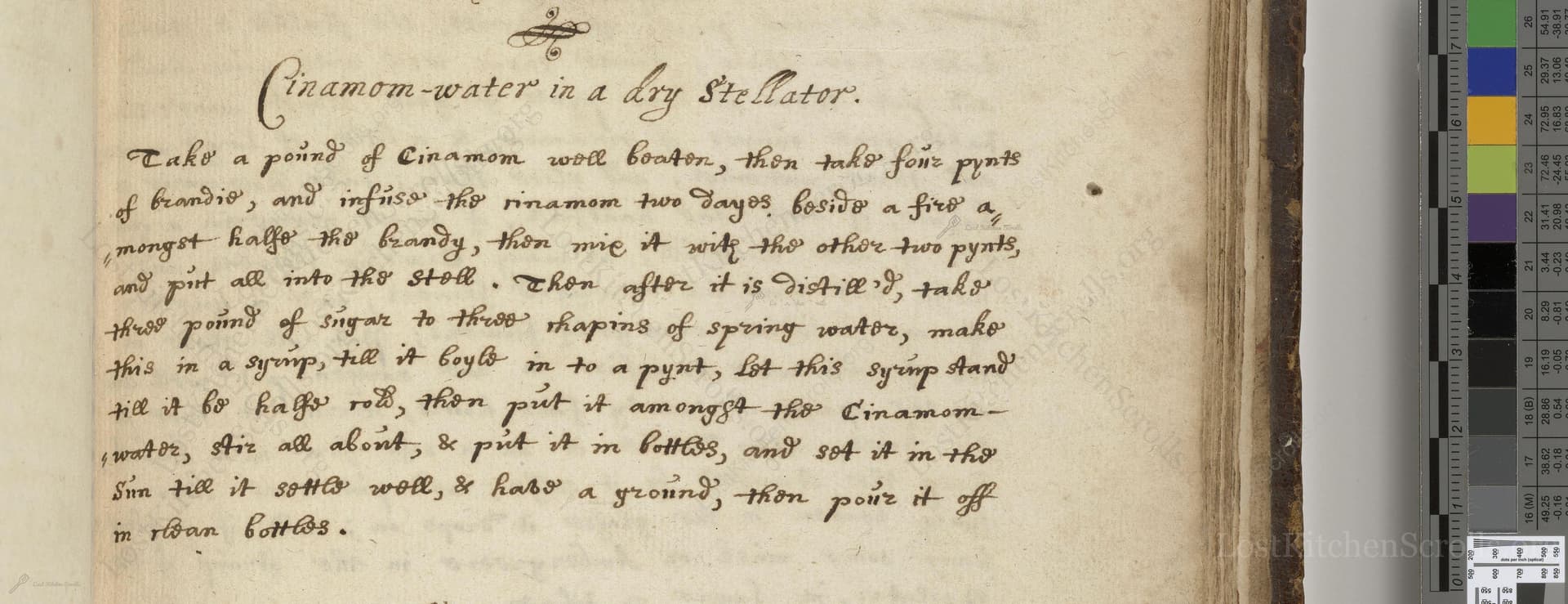Cinamom-Water In A Dry Stellator
From the treasured pages of Receipt book
Unknown Author

Cinamom-Water In A Dry Stellator
"Take a pound of Cinamom woll beaton, then take four pynts of brandie, and infuse the Cinamom two dayes beside a fire, & mongst halfe the brandie, then mix it with the other two pynts, and put all into the Still. Then after it is Distill'd, take three pound of sugar to three shapins of spring water, make this in a syrup, till it boyle into a pynt, Let this syrup Stand till it be halfe cold, then put it amongst the Cinamom- water, Stir all about, & put it in bottles, and Sot it in the Sun till it Settle woll, & have a ground, then pour it off in clean bottles."
Note on the Original Text
Seventeenth-century recipes like this favor brevity and assume familiarity with kitchen chemistry and processes such as infusing (maceration), distilling, and clarifying ('settling'). Spelling was unconstrained—'Cinamom' for 'cinnamon,' 'pynt' for 'pint,' and verbs like 'boyle' or 'beaton' reflect phonetic usage common at the time. Quantities were given in pounds and pints ('shapins'), which the modern cook must carefully translate. Directions often leave timing and temperatures to the reader's judgment, reflecting the experiential, apprentice-based knowledge of cooks in early modern households.

Title
Receipt book (1670)
You can also click the book image above to peruse the original tome
Writer
Unknown
Era
1670
Publisher
Unknown
Background
A delightful voyage through 17th-century kitchens, this manuscript tempts the senses with timeless recipes, forgotten flavors, and the intrigue of historical culinary craft. Savory secrets and sweet indulgences await within its well-worn pages.
Kindly made available by
Folger Shakespeare Library
This recipe hails from England in the latter half of the 17th century (circa 1660s–1680s), a time when the English gentry delighted in alcoholic cordials and flavored waters known as 'waters.' Cinnamon was a prized spice, imported at great cost, and such recipes hovered between medicine and luxury drinks. The technique also reflects burgeoning scientific interest in distillation and the preservation of exotic flavors for both health and pleasure.

In the original kitchen, cooks would have used a 'dry stellator,' or dry still—an alembic or glass/metal pot still without additional water in the base, heated over coals. They’d use ceramic or glass jugs for maceration, copper or pewter pans for syrup-making, and glass bottles sealed with corks or wax for storage. Sunlight played a practical role in settling and clarifying the mixture.
Prep Time
45 mins
Cook Time
1 hr
Servings
25
We've done our best to adapt this historical recipe for modern kitchens, but some details may still need refinement. We warmly welcome feedback from fellow cooks and culinary historians — your insights support the entire community!
Ingredients
- 1 pound (16 ounces) cinnamon sticks, roughly crushed
- 2 quarts (about 68 fluid ounces) brandy
- 3 pounds granulated sugar
- 7 cups (1.75 quarts) spring or filtered water
Instructions
- To make cinnamon-water using modern kitchen tools and ingredients, start by coarsely crushing 1 pound (16 ounces) of cinnamon sticks.
- Place half of the cinnamon (8 ounces) in a clean jar with 1 quart (about 34 fluid ounces) of brandy, and leave it near a warm spot (such as atop the fridge or in a very slightly warmed oven, turned off) to infuse for 2 days.
- After 2 days, mix in the rest of the brandy with the cinnamon mixture, combine both portions together.
- Pour the resulting mixture into a distillation apparatus, such as a modern rotary evaporator or a home distilling kit, and gently distill.
- Collect the distilled cinnamon-infused spirit.
- Meanwhile, dissolve 3 pounds of sugar in 7 cups (1.75 quarts) water (spring or filtered), heat and simmer gently until the mixture reduces to about 2.4 cups (a thick syrup).
- Let the syrup cool until only warm, then mix it into the distilled cinnamon-water.
- Stir thoroughly, pour into bottles, and place in a sunny window for several hours to help settle any sediment.
- Once settled, decant or filter the clear liquid into clean bottles, discarding the sediment.
Estimated Calories
170 per serving
Cooking Estimates
Preparing and infusing the cinnamon with brandy takes about 2 days. Cooking time includes making and reducing the sugar syrup. Prep time covers crushing cinnamon, assembling the ingredients, and setting up your distillation equipment. One serving is about 45 ml (a shot), and calories are based mostly on the sugar syrup.
As noted above, we have made our best effort to translate and adapt this historical recipe for modern kitchens, taking into account ingredients nowadays, cooking techniques, measurements, and so on. However, historical recipes often contain assumptions that require interpretation.
We'd love for anyone to help improve these adaptations. Community contributions are highly welcome. If you have suggestions, corrections, or cooking tips based on your experience with this recipe, please share them below.
Join the Discussion
Rate This Recipe
Dietary Preference
Main Ingredients

Den Bockfisch In Einer Fleisch Suppen Zu Kochen
This recipe hails from a German manuscript cookbook compiled in 1696, a time whe...

Die Grieß Nudlen Zumachen
This recipe comes from a rather mysterious manuscript cookbook, penned anonymous...

Ein Boudain
This recipe comes from an anonymous German-language manuscript cookbook from 169...

Ein Gesaltzen Citroni
This recipe, dating from 1696, comes from an extensive anonymous German cookbook...
Browse our complete collection of time-honored recipes



